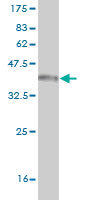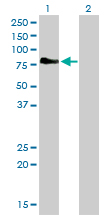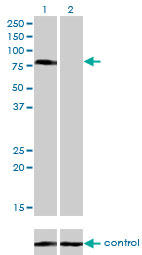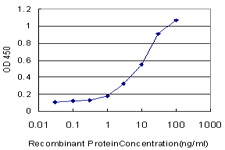CD97 Antibody (monoclonal) (M01)
Mouse monoclonal antibody raised against a partial recombinant CD97.
- SPECIFICATION
- CITATIONS
- PROTOCOLS
- BACKGROUND

Application
| WB, E |
|---|---|
| Primary Accession | P48960 |
| Other Accession | NM_078481 |
| Reactivity | Human |
| Host | mouse |
| Clonality | Monoclonal |
| Isotype | IgG2a Kappa |
| Clone Names | 5D5 |
| Calculated MW | 91869 Da |
| Gene ID | 976 |
|---|---|
| Other Names | CD97 antigen, Leukocyte antigen CD97, CD97, CD97 antigen subunit alpha, CD97 antigen subunit beta, CD97 |
| Target/Specificity | CD97 (NP_510966, 421 a.a. ~ 529 a.a) partial recombinant protein with GST tag. MW of the GST tag alone is 26 KDa. |
| Dilution | WB~~1:500~1000 E~~N/A |
| Format | Clear, colorless solution in phosphate buffered saline, pH 7.2 . |
| Storage | Store at -20°C or lower. Aliquot to avoid repeated freezing and thawing. |
| Precautions | CD97 Antibody (monoclonal) (M01) is for research use only and not for use in diagnostic or therapeutic procedures. |

Thousands of laboratories across the world have published research that depended on the performance of antibodies from Abcepta to advance their research. Check out links to articles that cite our products in major peer-reviewed journals, organized by research category.
info@abcepta.com, and receive a free "I Love Antibodies" mug.
Provided below are standard protocols that you may find useful for product applications.
Background
This gene is a member of the EGF-TM7 family of class II seven-span transmembrane (7-TM) molecules, likely encoded by a gene cluster on the short arm of chromosome 19. The encoded product is a glycoprotein that is present on the surface of most activated leukocytes and spans the membrane seven times, which is a defining feature of G protein-coupled receptors. The protein has an extended extracellular region with several N-terminal epidermal growth factor (EGF)-like domains, which mediate binding to its cellular ligand, decay accelerating factor (DAF, CD55), a regulatory protein of the complement cascade. The presence of structural features characteristic of extracellular matrix proteins and transmembrane proteins suggests that this protein is a receptor involved in both cell adhesion and signaling processes early after leukocyte activation. Alternative splicing has been observed for this gene and three variants have been found.
References
Variation at the NFATC2 Locus Increases the Risk of Thiazolinedinedione-Induced Edema in the Diabetes REduction Assessment with ramipril and rosiglitazone Medication (DREAM) Study. Bailey SD, et al. Diabetes Care, 2010 Jul 13. PMID 20628086.Role of CD97 isoforms in gastric carcinoma. Liu D, et al. Int J Oncol, 2010 Jun. PMID 20428763.The impact of expressions of CD97 and its ligand CD55 at the invasion front on prognosis of rectal adenocarcinoma. Han SL, et al. Int J Colorectal Dis, 2010 Jun. PMID 20339853.New genetic associations detected in a host response study to hepatitis B vaccine. Davila S, et al. Genes Immun, 2010 Apr. PMID 20237496.Differential expression of the EGF-TM7 family members CD97 and EMR2 in lipid-laden macrophages in atherosclerosis, multiple sclerosis and Gaucher disease. van Eijk M, et al. Immunol Lett, 2010 Apr 8. PMID 20167235.
If you have used an Abcepta product and would like to share how it has performed, please click on the "Submit Review" button and provide the requested information. Our staff will examine and post your review and contact you if needed.
If you have any additional inquiries please email technical services at tech@abcepta.com.













 Foundational characteristics of cancer include proliferation, angiogenesis, migration, evasion of apoptosis, and cellular immortality. Find key markers for these cellular processes and antibodies to detect them.
Foundational characteristics of cancer include proliferation, angiogenesis, migration, evasion of apoptosis, and cellular immortality. Find key markers for these cellular processes and antibodies to detect them. The SUMOplot™ Analysis Program predicts and scores sumoylation sites in your protein. SUMOylation is a post-translational modification involved in various cellular processes, such as nuclear-cytosolic transport, transcriptional regulation, apoptosis, protein stability, response to stress, and progression through the cell cycle.
The SUMOplot™ Analysis Program predicts and scores sumoylation sites in your protein. SUMOylation is a post-translational modification involved in various cellular processes, such as nuclear-cytosolic transport, transcriptional regulation, apoptosis, protein stability, response to stress, and progression through the cell cycle. The Autophagy Receptor Motif Plotter predicts and scores autophagy receptor binding sites in your protein. Identifying proteins connected to this pathway is critical to understanding the role of autophagy in physiological as well as pathological processes such as development, differentiation, neurodegenerative diseases, stress, infection, and cancer.
The Autophagy Receptor Motif Plotter predicts and scores autophagy receptor binding sites in your protein. Identifying proteins connected to this pathway is critical to understanding the role of autophagy in physiological as well as pathological processes such as development, differentiation, neurodegenerative diseases, stress, infection, and cancer.





